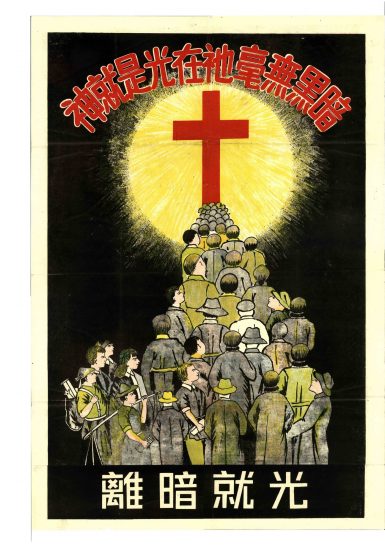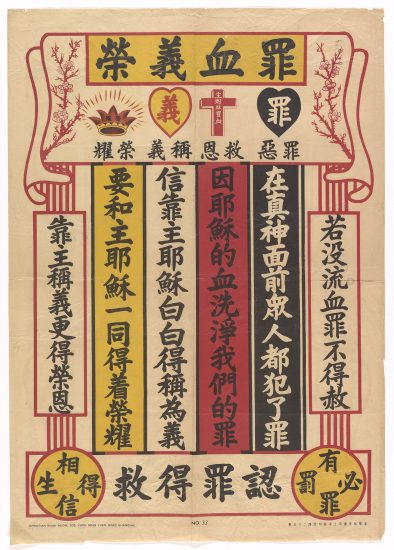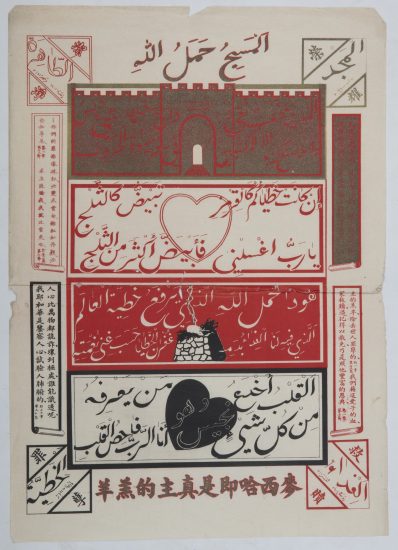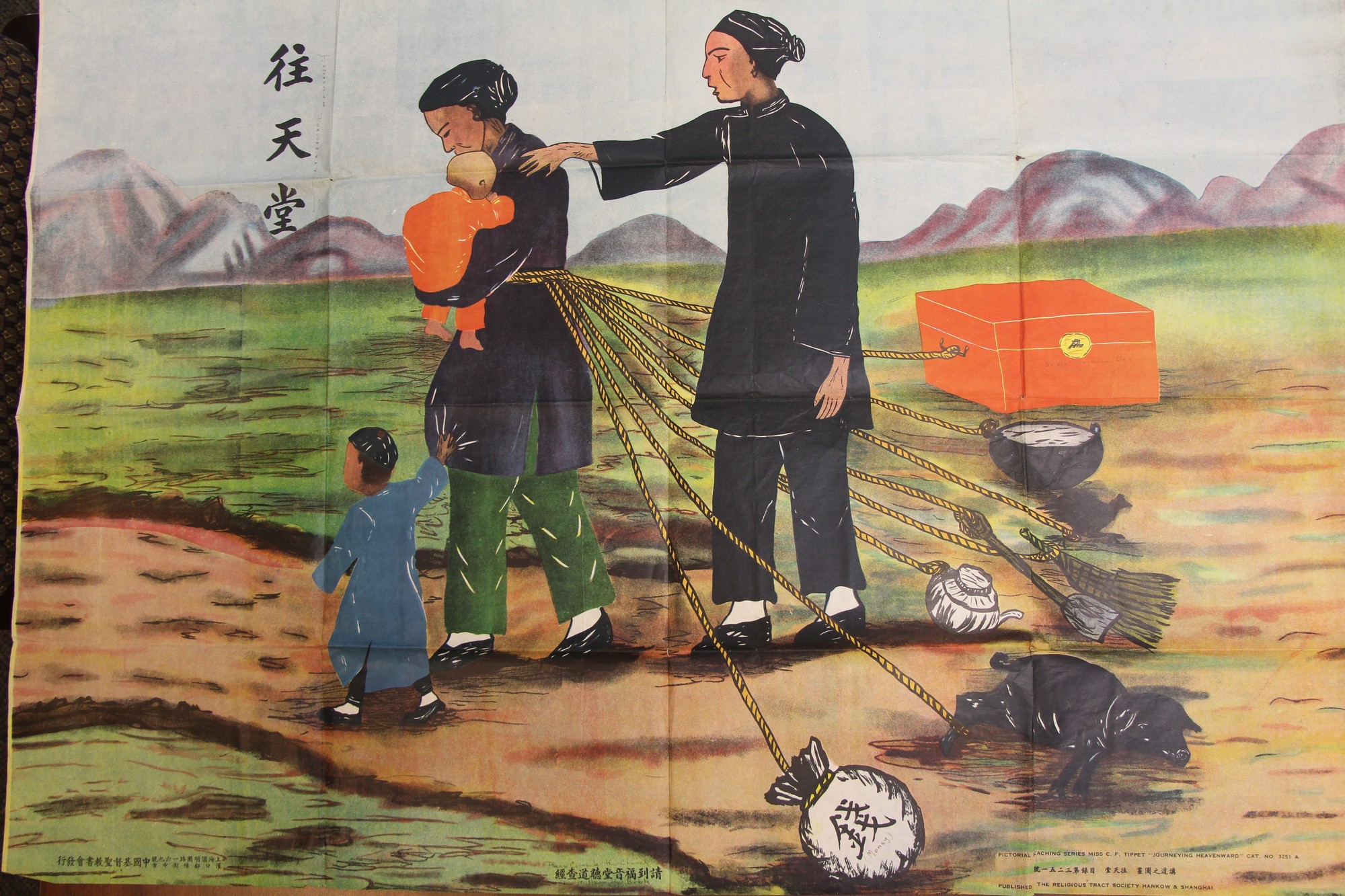How Evangelism Is Captured in time on Christian Posters




The Christian denomination, Evangelism, has taken on many different forms throughout its complex history and existence within China. In the Chinese Christian community, visual mediums such as posters play a significant role in conveying messages of faith and salvation. These posters ranged in visual appearances. From vibrant colors to incorporating other religions and addressing social issues. Thanks to these posters, exposure to Evangelism was possible.
The ultimate goal and purpose of these Christian posters were to allure people in. These posters had to catch the attention of the Chinese in a way that not only they could easy see what was depicted but would also cause them to walk away with questions. Hanging the gospel posters was the start of conversation. From these posters also came the combination of house visits, book purchases, singing, and the room for people to travel and share their own personal testimonies (Ireland 2023). When evangelist traveled to towns in groups they would all be delegated a different task. One may sing or play an instrument, one would hang the posters using paste and the crowds would soon come in to listen, from there came the opportunity to talk about christ.
The posters opened the space for the presence of evangelical Christianity. Once people had decided that they wanted to follow in this religion, these posters were hung inside people’s homes and businesses. They were essentially used as testimonies and as public witnesses to their faith and a symbol of communal solidarity (Ireland 121). When people saw the posters they knew that they were in the presence of Christians. For missionaries, these posters were another stratgey to spread the gospel. It was not their first and primary tool. Missionaries studied the Chinese culture in order to create the best ideas to help spread the gospel. ithin the city, town neighborhood, village, or rural distict was where the actual, hardcore contact between missionaries, non-Christians, and Christians took place (Bays1996,24). With missionaries educating themselves they craeted the posters to display what they had learned. With missionaries and Chinese christians putting up the poster’s anti-christian posters soon became the compeition. Christians were threatened to be killed for keeping the posters up and it soon turned into a competions of the Communist tearing down the posters and Christians putting them back up. Even with the hardships, the existence of these visual representations never died out.
The visual aspects of these posters continued to develop and thrive. The posters went from black and while to color and containing large amounts of intricate details. One thing that is very prominent and mostly seen on the posters was the Cross. As seen on the poster that is located on the far left titled “God Is Light.” The cross was used to represent God, salvation, Christ, and was ultimately the symbol of Christianity. With cross being red falls under the fact that these posters used a wide range of colors. A lot, or if not most of the colors had their own meanings. For example, the second poster, which is titled “Sin, Blood, Righteousness, Glory.” This poster displays the colors gold, black, red, and white. These colors represents God’s plan of redemption: black for sin; red for Jesus’ sacrifice, gold for heaven, and white for sanctification (Ireland 2023). The use of these colors contributed to the easy interpretation.
Not only was color and detail drawings introduced to these posters, but so was the introdcution of other languages and religions. The third poster, titled “Messiah Is the Lamb” depicts the four colors, the top color is actually gold. It also has Chinese written characters, and Arabic. This poster makes refences to the bible sections of Revelations, John, Jeremiah, and Ephesians. There were posters created that had infused other languages. As people started to obtain knowlege in other languages and religions, such as George K. Harris. This opened to the door to the combination of mutliple langauges being put on the posters. One time Harris got into a dispute with man about the topic of sin. With his combined knowledge on the Bible and the Qur’an, Harris won a dispute he was engaged in with another man on the topic of sin and enticed an audience and explained the path to salvation (Ireland 2023). The most intriguing these posters got, the room qutions, debates, and interest in other language came about.
The posters not only addressed Christianity but many of them also combated social issues. The last poster on the far right tited “Journeying Heavenward” by Charlotte F. Tippet is the the second part of the entire two poster pair. In this one there can been seen a women who is carrying one child and has another one standign at her feet. Her mother has her hand on the women’s shoulder, she is essentially holding the women back. Attached to the women is rope and at the ends of the rope is a red chest, a bag od money, a baby cow, a tea pot, a chicken, a broom, and a spade. All these items represent this womens burden. One way that social issue made the cover of these posters was due to women missionaries. Women missionaries initiated cultural exchange and promoted mutual understanding between Western and Chinese cultures. Because western missionary women had taken notice of the social issues in China that this opened the door them to establishing their own schools and created the right atmosphers to have cross-culture dialogue. For example, at St. Hilda’s school for girls, the western women missionaries were unbinding the feet of Christian girls because they were in protest against a cruel and heathenish practice (Liu 2011,83). This poster connects to the idea of what christ and salvation can offer women while bringing attention to social issues. Social issues were used in these posters as a way to express sin and give the idea of how Christ can take the burdens from social issues away from individuals, specifically women.
I find beauty, fascination, and meaning within all of these posters. I am fascinated by how colors were not only at some point added to the posters but how these colors still held meaning to the Chinese culture and stood for different aspects of Christianity. It created a set standard for these posters. When people saw these colors they knew that these posters address salvation, god, glory, sacrifice, and sin. These colors definitely aided in the level of understanding for those who were illiterate. I find beauty in the detail of these posters, from the writing strokes of the written characters to the small details in the shape of the bodies and the face expressions. It fascinates me to to know that multiple of one poster were created but still with the same details. I think that taking the risk of adding in another language and religion is also a beautiful thing. It definitely stresses the topic of religion but also presents it in such a fascinating way that it makes it hard for one to not compare or come to conclusions. I think that the posters definitely hit the mark of catching attention while also addressing Christianity the appropriate light.
In conclusions, Evangelism was displayed strongly through the creative, immensely detailed, and religious focused Christianity posters. The posters addressed social issues, tempaption, other religious and made it all work to properly address Christianity and helped with the number of converts in China.
Dana L. Robert.2023. Visions of Salvation Chinese Christian Poster in an Age of Revolution, Evangelism, ed. Daryl Ireland, Baylor University press, 114-117
Dana L. Robert. 2023. Visions of Salvation Chinese Christian Poster in an Age of Revolution, Evangelism, ed. Darly Ireland, Baylor University press, 121
Dana L. Robert. 2023. Visions of Salvation Chinese Christian Poster in an Age of Revolution, Evangelism, ed. Darly Ireland, Baylor University press, 124
Dana L. Robert. 2023. Visions of Salvation Chinese Christian Poster in an Age of Revolution, Evangelism, ed. Darly Ireland, Baylor University press, 128-129
Alan Richard Sweeten. 1996. Christianity in China: From the Eighteenth Century to the Present, Catholic Converts in Jiangxi Province: Conflict and Accommodation, ed. Daniel H. Bays, Stanford University press, 24
Judith Liu. 2011. Foreign Exchange: Counterculture behind the Walls of St. Hilda’s School for Girls, St. Hilda’s School for Girls, Lehigh University press, 83
Lorem ipsum dolor sit amet, consectetur adipiscing elit. Ut elit tellus, luctus nec ullamcorper mattis, pulvinar dapibus leo.
